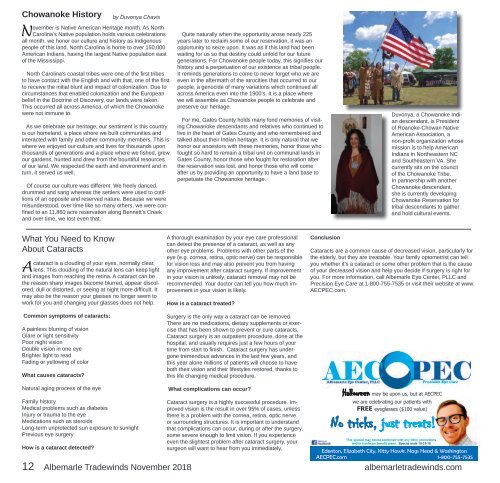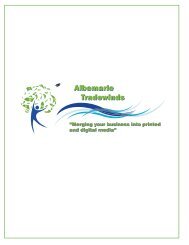Tradewinds November 2018 Web Opt
Albemarle Tradewinds November 2018 is now online. Look for the printed edition later in the week at your favorite location
Albemarle Tradewinds November 2018 is now online. Look for the printed edition later in the week at your favorite location
Create successful ePaper yourself
Turn your PDF publications into a flip-book with our unique Google optimized e-Paper software.
Chowanoke History<br />
by Duvonya Chavis<br />
<strong>November</strong> is Native American Heritage month. As North<br />
Carolina’s Native population holds various celebrations<br />
all month, we honor our culture and history as Indigenous<br />
people of this land. North Carolina is home to over 150,000<br />
American Indians, having the largest Native population east<br />
of the Mississippi.<br />
North Carolina’s coastal tribes were one of the first tribes<br />
to have contact with the English and with that, one of the first<br />
to receive the initial blunt and impact of colonization. Due to<br />
circumstances that enabled colonization and the European<br />
belief in the Doctrine of Discovery, our lands were taken.<br />
This occurred all across America, of which the Chowanoke<br />
were not immune to.<br />
As we celebrate our heritage, our sentiment is this country<br />
is our homeland, a place where we built communities and<br />
interacted with family and other community members. This is<br />
where we enjoyed our culture and lives for thousands upon<br />
thousands of generations and a place where we fished, grew<br />
our gardens, hunted and drew from the bountiful resources<br />
of our land. We respected the earth and environment and in<br />
turn, it served us well.<br />
Of course our culture was different. We freely danced,<br />
drummed and sang whereas the settlers were used to cotillions<br />
of an opposite and reserved nature. Because we were<br />
misunderstood, over time like so many others, we were confined<br />
to an 11,860 acre reservation along Bennett’s Creek<br />
and over time, we lost even that.<br />
Quite naturally when the opportunity arose nearly 225<br />
years later to reclaim some of our reservation, it was an<br />
opportunity to seize upon. It was as if this land had been<br />
waiting for us so that destiny could unfold for our future<br />
generations. For Chowanoke people today, this signifies our<br />
history and a perpetuation of our existence as tribal people.<br />
It reminds generations to come to never forget who we are<br />
even in the aftermath of the atrocities that occurred to our<br />
people, a genocide of many variations which continued all<br />
across America even into the 1900’s. It is a place where<br />
we will assemble as Chowanoke people to celebrate and<br />
preserve our heritage.<br />
For me, Gates County holds many fond memories of visiting<br />
Chowanoke descendants and relatives who continued to<br />
live in the heart of Gates County and who remembered and<br />
talked about their Indian heritage. It is only natural that we<br />
honor our ancestors with these memories, honor those who<br />
fought so hard to remain a tribal unit on communal lands in<br />
Gates County, honor those who fought for restoration after<br />
the reservation was lost, and honor those who will come<br />
after us by providing an opportunity to have a land base to<br />
perpetuate the Chowanoke heritage.<br />
Duvonya, a Chowanoke Indian<br />
descendant, is President<br />
of Roanoke-Chowan Native<br />
American Association, a<br />
non-profit organization whose<br />
mission is to help American<br />
Indians in Northeastern NC<br />
and Southeastern VA. She<br />
currently sits on the council<br />
of the Chowanoke Tribe.<br />
In partnership with another<br />
Chowanoke descendant,<br />
she is currently developing<br />
Chowanoke Reservation for<br />
tribal descendants to gather<br />
and hold cultural events.<br />
What You Need to Know<br />
About Cataracts<br />
cataract is a clouding of your eyes, normally clear,<br />
A lens. This clouding of the natural lens can keep light<br />
and images from reaching the retina. A cataract can be<br />
the reason sharp images become blurred, appear discolored,<br />
dull or distorted, or seeing at night more difficult. It<br />
may also be the reason your glasses no longer seem to<br />
work for you and changing your glasses does not help.<br />
Common symptoms of cataracts:<br />
A painless blurring of vision<br />
Glare or light sensitivity<br />
Poor night vision<br />
Double vision in one eye<br />
Brighter light to read<br />
Fading or yellowing of color<br />
What causes cataracts?<br />
Natural aging process of the eye<br />
Family history<br />
Medical problems such as diabetes<br />
Injury or trauma to the eye<br />
Medications such as steroids<br />
Long-term unprotected sun exposure to sunlight<br />
Previous eye surgery<br />
How is a cataract detected?<br />
A thorough examination by your eye care professional<br />
can detect the presence of a cataract, as well as any<br />
other eye problems. Problems with other parts of the<br />
eye (e.g. cornea, retina, optic nerve) can be responsible<br />
for vision loss and may also prevent you from having<br />
any improvement after cataract surgery. If improvement<br />
in your vision is unlikely, cataract removal may not be<br />
recommended. Your doctor can tell you how much improvement<br />
in your vision is likely.<br />
How is a cataract treated?<br />
Surgery is the only way a cataract can be removed.<br />
There are no medications, dietary supplements or exercise<br />
that has been shown to prevent or cure cataracts.<br />
Cataract surgery is an outpatient procedure, done at the<br />
hospital, and usually requires just a few hours of your<br />
time from start to finish. Cataract surgery has undergone<br />
tremendous advances in the last few years, and<br />
this year alone millions of patients will choose to have<br />
both their vision and their lifestyles restored, thanks to<br />
this life changing medical procedure.<br />
What complications can occur?<br />
Cataract surgery is a highly successful procedure. Improved<br />
vision is the result in over 95% of cases, unless<br />
there is a problem with the cornea, retina, optic nerve<br />
or surrounding structures. It is important to understand<br />
that complications can occur, during or after the surgery,<br />
some severe enough to limit vision. If you experience<br />
even the slightest problem after cataract surgery, your<br />
surgeon will want to hear from you immediately.<br />
Conclusion<br />
Cataracts are a common cause of decreased vision, particularly for<br />
the elderly, but they are treatable. Your family optometrist can tell<br />
you whether it’s a cataract or some other problem that is the cause<br />
of your decreased vision and help you decide if surgery is right for<br />
you. For more information, call Albemarle Eye Center, PLLC and<br />
Precision Eye Care at 1-800-755-7535 or visit their website at www.<br />
AECPEC.com.<br />
12 Albemarle <strong>Tradewinds</strong> <strong>November</strong> <strong>2018</strong> albemarletradewinds.com

















